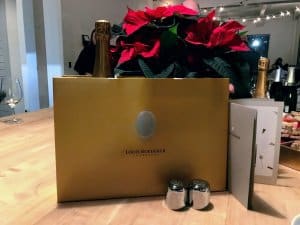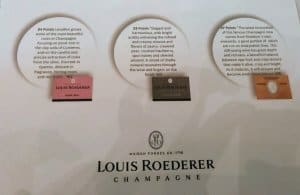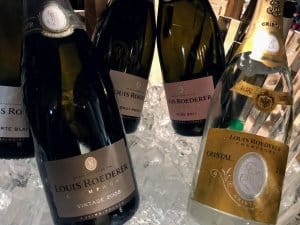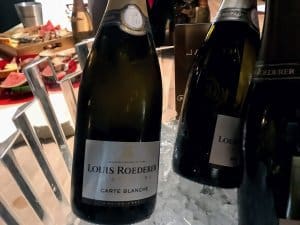
“You buy the big houses for the name, you buy the growers for the wine.”
In my post Cristal Clarity, I featured the quote above while discussing the dichotomy in the world of Champagne between the mega-corp négociant houses and the small grower producers. As I sat down for dinner at Daniel’s Broiler in Bellevue for their 10th Annual Champagne Gala, that quote began ringing in my ears from the moment the staff handed me my “long neck” of Moët & Chandon Brut Imperial.
For the second straight year, Daniel’s Broiler partnered with LVMH (Louis Vuitton Moët Hennessy) for their annual gala. From listening to other attendees, a few years ago the gala was also LVMH-centric with the wines of Veuve Clicquot featured and it sounds like the very first Champagne Gala at Daniel’s was also based around Moët & Chandon.
It seems that LVMH dominants the attention of Daniel’s wine team as much as it dominants the global Champagne market.
Passed hors d’oeuvres paired with Moët & Chandon Brut Impérial “long necks”
Treasure cove oysters with salmon roe, chili, ginger and chives. Crostinis with brown-butter scallions, wild mushrooms and ricotta.
This….was an interesting experience. I know the use of Champagne flutes is going out of fashion but being told that this was the “hot new trend” in drinking bubbles struck myself (and I suspect most of the room) as quite odd.
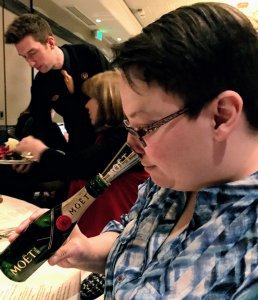
Trying to “smell” the long neck Moët & Chandon
The Moët & Chandon Brut Impérial is a non-vintage blend made up of more than 100 different wines with 20-30% being “reserve wines” from older vintages. The blend varies from batch to batch and will usually have 30-40% Pinot noir, 30-40% Pinot Meunier and 20-30% Chardonnay. I was quite surprised to learn from the LVMH brand ambassador, Coventry Fallows, that the dosage for the Brut Imperial has been lowered over the years to 9 g/l. That is still on the “sweeter side” of Brut but it is an improvement over the 12 g/l that skirted the line between Brut and Extra Dry and a huge change from the 20 g/l dosage of their White Star label that was once a staple on the US market but has since been discontinued.

I think Garth Brooks sang a song about this.
While we were sipping our long necks and pairing them with the oysters and wild mushroom crostini, it was hard not to notice how utterly nondescript and indistinct the Brut Imperial was. It could have been a Cava, a Crémant or a Prosecco and no one would’ve fluttered an eye. It could have even been a sparkling wine in a can and still deliver the same neutral experience.
I asked my table mates if, instead of the Moët, they were sipping the Coppola Sofia California sparkler, would they have noticed a difference? Everyone said no which I think is a big crux for Moët and why this marketing gimmick is missing the mark. The Brut Imperial Champagne, itself, is nothing spectacular and memorable and it kind of feels like LVMH is getting bored with the brand that they crank out around 30 million bottles a year of.
Is the message that LVMH truly wants to send with these “long neck Moëts” is that Moët & Chandon Brut Imperial is the Bud Light of the Champagne world?
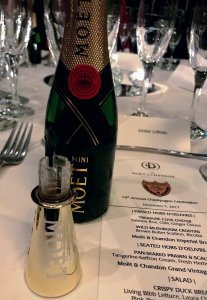
I wonder if this will fit into a bottle of Bud Light?
First utilized by Moët for the 2015 Golden Globes, it appears that LVMH is trying their darnedest to make “fetch happen” with sipper tops on 187 ml splits. As a hugely successful multinational conglomerate, LVMH’s branding is closely associated with luxury (with many of their Champagnes like Veuve Clicquot and Moët & Chandon needing that association as part of their branding) which makes it a bit humorous that they’re marketing their wine by making you feel like you’re drinking a beer.
But hey… it’s Champagne! And its gold colored so you’re being both chic and avant-garde at the same time! There’s that, I guess.
If you want to indulge in your inner Coachella hipster, you can purchase your own Moët sipper top on Amazon and, of course, can find Moët & Chandon Brut Impérial at virtually any wine shop, grocery store or gas station.
However, considering that you can get four 187 ml Sofia cans for the same price as one Moët Brut Imperial split (minus the $8 “long neck adapter”) and still have the same amount of care-free fun drinking your bubbles like beer, I think I’m going to pass. I’ve always been more of a SXSW girl anyways.
Seated hors d’oeuvre paired with Moët & Chandon Grand Vintage Brut 2008
Seared scallops and prawns with tangerine-saffron cream, fresh herbs and vol-au-vent.
The highlight of the event was the expertise offered by LVMH Brand Ambassador Coventry Fallows who was a wealth of knowledge and is very skilled at presenting the wines she represents. It was unfortunate, however, that rather than give her more time to offer more in-depth and detailed information about each wine to the group as a whole, her presentation was shorten for each wine to just a few moments with her working the room, going from table to table with the overall noise of surrounding tables drowning out her answers to the various questions presented.

But, from the little bit that I was able to gleam from her in those brief moments, I learned that the general philosophy of Moët & Chandon is that “Bigger is Better” and that, in addition to being a significant négociant buyer of fruit, they are also the largest vineyard owner in Champagne and are constantly seeking out more quality land to add to their holdings. This is encouraging because as we discovered with the wines of Roederer, the more direct house control of the process from grape to glass, the more likely you are to get a high quality and character driven product.
With those thoughts in mind, I was eager to try the 2008 Vintage Brut which represents only around 5% of the house’s production and is made entirely from estate-owned fruit.
The 2008 Moët & Chandon Brut is a blend of 40% Chardonnay, 37% Pinot noir and 23% Pinot Meunier. It was aged 7 years on the lees before being bottled with a dosage of 5 g/l that is the lowest among the entire Moët line. Much of the fruit sourced for the wine comes from Premier Cru and Grand Cru vineyards that have been declassified from the Dom Perignon range.
The wine had medium minus intensity on the nose with some candied hazelnut and spice pear notes. On the palate, the pear seemed to go away and was replaced by more appley-notes while the candied hazelnuts become more pastry dough–like a nut-filled apple strudel. The finish was quite short.
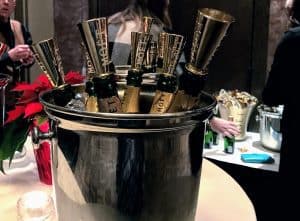
And the Vintage Brut is a huge step up from drinking beer.
The mouthfeel was the star with smooth, silky bubbles that showed great balance between the acidity and the low dosage. The reason why so many Champagnes veer towards the “sweeter side of Brut” is because sugar is the magic pill when it comes to insuring a smooth and velvety soft mouthfeel that is so desirable–especially for the American market. It takes high quality fruit and skilled winemaking to accomplish similar results without the crutch of sugar so I will certainly give Moët’s chef de cave Benoit Gouez his due credit for his craftsmanship and balance with this Champagne.
However, there are plenty of well crafted and well balanced Champagnes (including many 100% Grand Crus) that can be found for around $40-55, far less than the $65-70 that the Moët & Chandon Grand Vintage Brut usually commands. On the other hand, as a “baby Dom”, it actually is a better value when compared to spending $130-150 for some of the less-exciting vintages of Dom Perignon. (More on that below)
For me, the food provided by Daniel’s head chef Kevin Rohr was far more exciting with the scallops being perfectly pan-seared and fresh. The tangerine-saffron cream added a delightful twist of flavor that seemed both light and rich. The prawns were more hit and miss with half the table having no issue but the other half describing a “chlorine” and overly fishy taste to them that suggest there may have been some bad ones in the batch.
Salad paired with Moët & Chandon Rosé Impérial
Crisped duck breast with butter lettuce, Laura Chenel’s chèvre, pink peppercorns and pomegranate glacé.
Another tidbit from Ms. Fellows was that the house style of Moët is that of “Freshness and Crispness”. Perhaps no other wine showcased that emphasis more than the Rosé Impérial.
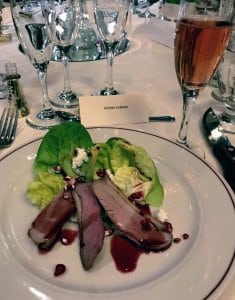
The Rosé Impérial is a non-vintage blend like the Brut Imperial with the percentage of grapes in the blend varying from batch to batch. The blend is usually around 40-50% Pinot noir, 30-40% Pinot Meunier and 10-20% Chardonnay with the rose coloring come from the addition of 20% blend of red Pinot noir and Pinot Meunier wine. Like the Brut Imperial, the dosage is 9 g/l with around 20-30% of reserve wine to help insure consistency.
The wine had a medium-plus intensity nose with cherry aromas and fresh red apple peels. Outside of the 2004 Dom Perignon, it had the best nose of the night. The palate carried that lively freshness through with the apple peel being the strongest note but with some strawberry notes joining the cherry on the finish. The one major slight, which was an unfortunate shared trait among all the wines of the evening, was the incredibly short finish that completely disappears mere moments after swallowing.
At around $50-55, you are still paying a premium for it being a rosé (and the Moët name) but, in hindsight of the evening, the Rosé Impérial is one of the better values in the entire Moët portfolio.
Again, the food was excellent with the pairing enhancing the wine. The pomegranate glacé with pink peppercorns were immensely charming and complimented the sense of freshness of the rosé with the tanginess of the chèvre cheese adding some length to the short finish of the wine. Even though it was certainly not “crispy” by any definition, the duck was beautifully cooked and juicy.
Entrée paired with 2004 and 2006 vintages of Dom Pérignon
USDA Prime beef tenderloin with butter-poached North Atlantic lobster tail, green risotto and Béarnaise sauce.
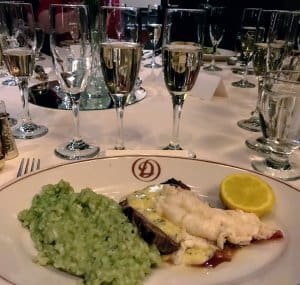
While technically part of Moët & Chandon, LVMH prefers for people to think of Dom Perignon as its own house and entity. Indeed, its production is distinct from the rest of the Moët lineup with its own chef de cave, Richard Geoffroy, overseeing production. Like the man himself, the wine has been the subject of many myths and breathless soliloquies.
Some of the hype is richly deserved with many bottles of Dom Perignon being ranked as some of the greatest wines ever made.
For myself, personally, the 1996 Dom Perignon will always hold a warm spot in my heart as a magical wine that made the light bulb flick on for me about the beauty that wine offers. In many ways, I’m always comparing every wine I taste to that sublimely perfect bottle of 1996 Dom which may be why I’ve been so dishearten watching (and tasting) the changing style of Dom Perignon.
Of course the change started happening long before my magical 1996, but at some point Moët & Chandon made the decision that Dom Perignon was going to be marketed as more of a brand and lifestyle rather than necessarily as a wine. When you no longer have to sell something based on just the intrinsic quality of the wine, you are no longer limited in how many bottles you can produce. Though notoriously secretive about exact production figures, as of 2013 estimates were that around 5 million bottles of Dom Perignon are produced each vintage.
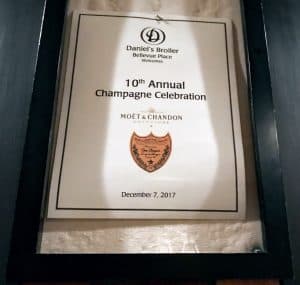
If Daniel’s runs out of ideas for future Champagne Gala events, we know there will always be plenty of Dom available.
While I’m sure they are having no problems selling those 5 million bottles each year (especially since the excess production has allowed the price to drop from $200-240 to around $130-150) perhaps it is no surprise that companies are finding plenty of Dom Perignon available to make gummie bears with.
The concept of “Vintage Champagne” was originally centered around the idea of a special bottling made only in exceptional vintages, but we are now seeing more and more vintages of Dom Perignon declared with 13 of the 41 vintages made between 1921 and 2006 coming after 1990. There are upcoming plans to release a 2008 & 2009 vintages as well. The increase in declared vintages is credited to global warming producing better vintages but, in comparison, Champagne Salon has only released 8 vintages since 1990. And in the years that they do declare a vintage, Salon only makes around 60,000 bottles.
The trade-off, of course, is fewer gummie bears.
That said, while Dom Perignon is clearly no longer one of the top prestige cuvees in the world. It is still a good Champagne, sourced from Premier Cru and Grand Cru vineyards in Aÿ, Avize, Bouzy, Verzenay, Mailly, Chouilly, Cramant and Le Mesnil-sur-Oger, that can deliver adequate pleasure in the $100+ range so I enjoyed the opportunity to try two vintages side-by-side.
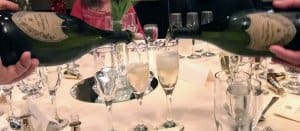
Double fisting Dom
The 2004 vintage is a blend of 52% Pinot noir and 48% Chardonnay with a dosage of 6 g/l. The exact details for the 2006 Dom Perignon weren’t given out at the dinner (and I couldn’t find them online) but I suspect the dosage is similar and Robert Parker has described the 2006 as more Chardonnay dominate. Each vintage of Dom Perignon is now released in three tranches called Plenitudes with the first (or regular) release of Dom being P1 that is released after the Champagne has spent 8 years aging on the lees.
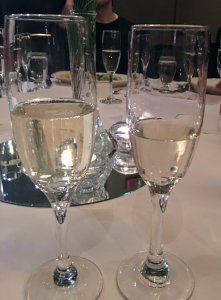
My wife was originally annoyed about the uneven pours of the two Doms (2004 on left, 2006 on right) until she tasted them and realize she wasn’t missing much with not getting more 2006.
The second release of each vintage (P2) will see 16 years aging on the lees with the final plenitude (P3) being released after 21 years. While I have not had the privilege of trying a P2 or P3 release, there has only been 19 and 4 releases respectively, I will confess to being intrigued at their potential though admittedly not terribly excited to spend the $360-1600 to purchase a bottle.
The 2004 had medium plus intensity aromatics that was actually quite inviting. It had an intriguing mix of tropical fruit and spice that had me thinking of the grilled cinnamon rubbed pineapple you get from a Brazilian steakhouse. There was also a fresh cedar and tobacco box component that takes you to a cigar humidor. These are usually notes I associated with a nice red Bordeaux so I thoroughly enjoyed the extra complexity it gave to the Champagne.
Unfortunately not all these notes carried through to the palate which tasted more butterscotch like a Werther’s Original. The mouthfeel was still fresh, keeping with the house style, and while the finish was longer than any of the other Champagnes, it was still regrettably short. The finish did introduce, though, a spiced pear component that I found intriguing if not fleeting.
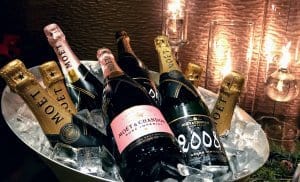
Both the rose and 2008 vintage overshadowed the 2006 Dom Perignon.
It paired very well with the beef tenderloin and, particularly, the lobster and Béarnaise sauce. Overall, the 2004 would be a wine that I would be content with for around $130-150 though certainly more thrilled with if I paid closer to $80-100.
The 2006, on the other hand, was pretty disappointing. I will give it the benefit of the doubt that it is a young release, and like with the Cristal, probably would benefit from more bottle age. You could also argue that it wasn’t benefiting from being compared next to the superior 2004 Dom Perignon (though technically the vintages themselves were of similar quality). But to be quite frank, the 2006 Dom Perignon lagged behind even the 2008 Moët & Chandon Grand Vintage Brut.
The nose was the most shy of the night with medium minus intensity. Some faint citrus peel and toasted coconut flakes. Very light and indistinct. It could have been served as a long neck beer like the Moët & Chandon Brut Imperial and it might not have made a difference. To the wine’s credit, those faint notes did carry through to the palate and added a praline pastry quality that seemed more buttery when paired with the lobster. The finish, following the chorus of the evening, was fleeting.
Dessert paired with Moët & Chandon Nectar Impérial
Champagne-poached pear with vanilla pot de crème and spicy glazed pistachios.
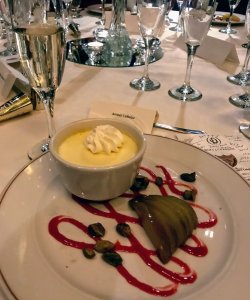
The Moët & Chandon Nectar Impérial is the house’s demi-sec offering and like with Roederer’s Carte Blanche is a tasty little gem that shows how overlooked the demi-sec category is. Following the pattern of the other wines of Moët & Chandon, this non-vintage Champagne is a Pinot dominant blend that includes 20-30% reserve wines. The exact composition varies but is usually around 40-50% Pinot noir, 30-40% Pinot Meunier and 10-20% Chardonnay. The dosage is 45 g/l or 4.5% residual sugar. To put that in context, that is just slightly less sweet than a late harvest Riesling like the 2015 Chateau Ste. Michelle Harvest Select that had 47 g/l residual sugar.
But balance is the name of the game and you can not underestimate the ability of the acidity and bubbles to offer an exceptional counter to the sweetness. Even though I compared the dosage to the sweetness level of the CSM Harvest Select Riesling, truth be told, I would reckon that most people who tasted the Moët & Chandon Nectar Impérial side by side with something like the 2015 Eroica Riesling (a relatively dry Riesling with great acidity and 11.8 g/l of residual sugar) would feel that the Riesling was sweeter.
The wine had medium intensity with candied oranges and fresh white peaches. Those notes carried through to the palate with the candied oranges morphing more into an apricot note. Next to the 2004 Dom Perignon, this had a tad longer finish than the other Moët wines which was a pleasant way to end the evening. While it didn’t jive with the raspberry sauce used in the dessert, it did very well with the vanilla pot de crème. While there are other demi-secs in the $45-55 range that have impressed me more, this was still a very solidly made Champagne with great balance that should be placed near the top of the Moët & Chandon portfolio.
Overall Impressions
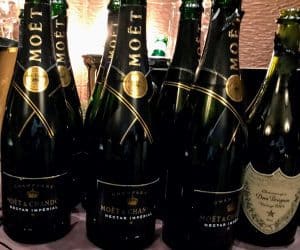
At the beginning of the event, Shawna Anderson, regional sales manager for Moët Hennessy USA, talked about the difference between the wines of the big houses like Moët & Chandon and grower producers. She said that with growers you never know what you get but with houses like Moët you get a consistent experience each time. And she’s right.
While I’m sure most readers can gleam my transparent affinity for hand crafted wine by smaller grower producers, I do not discount that there are sub-par and disappointing wines made by small growers. I also do not discount that large houses are built upon decades of sustained excellence that lay the bedrock of their growth. Likewise, I can’t argue that houses like Moët & Chandon are not consistent.
But then…. so is McDonald’s.
Outside of the 2006 Dom Perignon, I wasn’t disappointed with any of the wines featured at the Champagne Gala. Though I could certainly name at least a half dozen other Champagnes at lower or equivalent prices to the Moët & Chandon line up (some by big houses, some by smaller growers) that out performed the Champagnes of Moët & Chandon in delivering character and complexity, I can’t say that any of these wines are bad and not deserving to be purchased and enjoyed by people wanting a reason to celebrate.
It’s perfectly fine if you want to go dancing with Goliath. But folks should be clear that what they’re paying for in seeking the privilege of that dance is not necessarily for the quality in the bottle but, rather, for the name on the label.
For a review of last year’s Champagne gala see A Toast to Joy and Pain.

